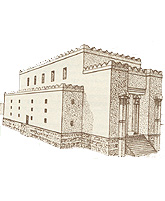|
|
|

The Biblical Sources
|
Biblical tradition holds that the foundations of the Jerusalem temple were laid in the fourth year of King Solomon (circa 964 BCE), and that the building was completed seven years later, in his eleventh year (1 Kings 6:37-38). Elsewhere (2 Samuel 7) it states that King David was denied the privelege of building the temple, although (see 1 Chronicles) he had even prepared the building materials, the workermen and the financial means for the project. It was he who had provided Solomon the plans of the temple, which he had envisioned through prophecy. |
|
The temple survived for nearly 380 years. It was burnt down on the seventh day of the month of Av, 586 BCE, by Nebuzaradan, captain of the guard under Nebuchadnezzar king of Babylon (2 Kings 25:8). During this period of time the physical plan of the temple had undergone several changes, and its religious functions and social status evolved as well. According to the first Book of Kings, for example, the temple had no accessible chambers or magazines but the second Book of Kings and Ezekiel mention functions requiring service spaces. The restoration of parts of the temple, known as the “repairing of the breaches of the house”, took place at least during two periods: the days of King Jehoash and Jehoiada the priest (2 Kings 12:7-17) and in the days of King Jehoahaz and Hilkiya the priest (2 Kings 23:9-13). It seems probable that such renovations were affected by other kings as well, and included alterations in the temple's structure and its decorations. |
|
Other changes, related to religious or political affairs, were introduced, for example, by King Ahaz, who, aided by Urijah the priest, replaced Solomon's copper altar with a new “great altar”, fashioned in the shape of an altar the king had seen in Damascus, where he met with Tiglath Pileser III; the old altar was reinstated to the north of the new one (2 Kings 16:10-18). King Hezekiah broke the copper serpent that Moses had made, and removed the gold from the doors of the temple and gave it to Sennacherib, king of Assyria, as part of the taxes he owed him (2 Kings 16:10-18). |

|


